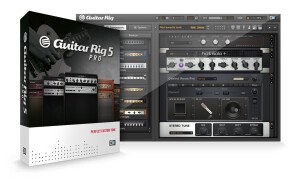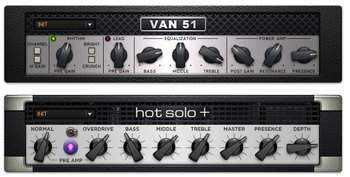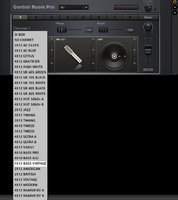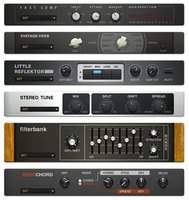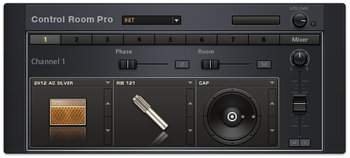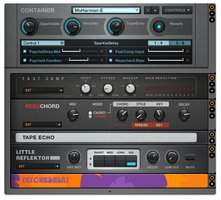Within a few years, Guitar Rig has become a reference in the world of guitar amps and effects simulation. The fourth version, which saw the light of day about two years ago, already brought major sound quality improvements with itself thanks to the new –however limited— Control Room feature... Can the German manufacturer surprise us with this fifth version? Read on...
Guitar Rig Pro is one of the pioneers in the history of guitar amp simulation and thus it is now a pretty mature product. This fifth version doesn’t introduce major improvements but rather fills some gaps in the features list. As usual, this new version includes new amps and effects, an improved Control Room (which first integrated convolution technology into Guitar Rig, see the Guitar Rig 4 Pro review), and some new features that will be useful to certain users…
Let’s start with the two new amps: Van 51 and Hot Solo+.
Two Amps for a Wall of Sound
One thing must be clear: if you don’t like distortion, the two new simulations aren’t for you. The first one is an emulation of the famous Peavey 5150, the amp of Mr. Van Halen, famous for his high-gain sound, palm muting and tapping, and his drop-D tuning. This amp, appropriately named “Van 51,” has two channels. The rhythm channel features two switches: Bright and Crunch, while both channels share a 3-band EQ, a Post Gain control (master volume), a Resonance control (low frequencies), a Presence control (high mids) and a Hi-Gain switch. Even if the amp wasn’t conceived with clean sounds in mind, we tried it out with a 335 and a Telecaster, and the results are quite ok even if not jaw-dropping. With an ESP or an Ibanez in the lead channel, the amp was much more convincing. The tone is accurate but not too artificial. Moreover, both guitars sounded different, meaning that the software stays faithful to the instrument, which is often not the case with amp simulations. The addition of this amp is good news because Guitar Rig was quite convincing with clean and crunch sounds, but distortion was not at the same level.
With our Les Paul the difference between the two channels is pretty evident. The Rhythm channel sounds very heavy, but the sound is nice! With a Telecaster you can hear the twang of the instrument, which is a good point. In short, the Van 51 isn’t limited to heavy metal guitars with high-output pickups. This is a nice surprise that enriches the software’s already comprehensive amp collection.
The second amp is the Hot Solo+. Based on the Soldano SLO (Super Lead Overdrive) 100, which is not an amp for dance balls but is considered the ultimate amp by many guitar players. This high-quality boutique amp is eagerly waiting for your high-speed solos! It provides two channels (Normal and Overdrive) with independent gain settings, 3-band EQ, Master, Presence (high mids) and Depth (low frequencies) controls. The good news is that the Hot Solo+ is available with two very different speaker cabinets. We recommend you to combine both cabinets for your guitar recordings because they complement each other very well, allowing you to fatten your sound. We recorded the same takes with the same settings but changing the cabinet so that you can hear the differences. With the 335 and the Telecaster in clean mode, the amp gives better results than the Van 51. The sound is deeper and definitely useful, even if we might prefer some other amps available in Guitar Rig Pro. With the Telecaster and the Les Paul in crunch mode the sound difference between the speaker cabinets is obvious. You’ll notice that the second one is more hollow. In high-gain mode, the Hot Solo+ is very convincing regardless of the guitar (Les Paul, Ibanez RG or ESP).
Check out the sound samples and make your own opinion:

- Amp – 335 Van 51 Clean00:16
- Amp – Telecaster Van 51 Clean00:23
- Amp – Les Paul Van 51 Canal Rythm00:23
- Amp – Telecaster Van 51 Canal Rythm00:22
- Amp – ESP Van 51 Canal Lead00:20
- Amp – Ibanez RG Van 51 Canal Lead00:18
- Amp – Les Paul Van 51 Canal Lead00:20
- Amp – Telecaster Hot Solo + Clean Cab 100:23
- Amp – Telecaster Hot Solo + Clean Cab 200:23
- Amp – 335 Hot Solo + Jazz Cab 100:16
- Amp – 335 Hot Solo + Jazz Cab 200:16
- Amp – Les Paul Hot Solo + Blues Cab 100:23
- Amp – Les Paul Hot Solo + Blues Cab 200:23
- Amp – Telecaster Hot Solo + Blues Cab 100:22
- Amp – Telecaster Hot Solo + Blues Cab 200:22
- Amp – ESP Hot Solo + Metal Cab 100:20
- Amp – ESP Hot Solo + Metal Cab 200:20
- Amp – Les Paul Hot Solo + Metal Cab 100:20
- Amp – Les Paul Hot Solo + Metal Cab 200:20
- Amp – Ibanez RG Hot Solo + Metal Cab 100:18
- Amp – Ibanez RG Hot Solo + Metal Cab 200:18
Always More Effects…
When it comes to effects, it features six new modules, including Fast Comp, a vintage and warm-sounding compressor designed for clean sounds that is very easy to use: adjust the input level, the attack time and the Makeup Gain control to compensate for the loss of level. We tried it out with a funky guitar part using fast and slow attack settings. If you listen to the “Fast” file, you’ll notice that the compressor does its job pretty well.

- FX – Fast Comp Off00:20
- FX – Fast Comp On Slow00:20
- FX – Fast Comp On Fast00:20
The second effect is called Vintage Verb. As the name implies, it is an old-school reverb with plate and spring-type algorithms. Native Instruments recommends it not only for its retro sound but also because it adds more personality to your guitars. Its controls are extremely simple: mix and algorithm selector. For these examples we used fairly high settings so that you can hear the effect easier. The German manufacturer has complemented the spring reverb, which didn’t provide as many possibilities — a nice detail!

- FX – Vintage Verb Dub00:22
- FX – Vintage Verb Studio00:22
- FX – Vintage Verb Dual00:22
- FX – Vintage Verb Gold Short00:22
- FX – Vintage Verb Gold Long00:22
- FX – Vintage Verb Amp00:22
- FX – Vintage Verb Silver Short00:22
- FX – Vintage Verb Silver Long00:22
Let’s go on with the reverbs and check out the Little Reflektor, a convolution effect that is nothing more than Reflektor’s littler brother. It features eight impulses plus low cut and decay settings. All eight impulses are sorted in four categories: Short, Med, Long and XXL (two impulses per category). Simple and effective. You don’t get all the settings available with the Reflektor but don’t forget that you bought a guitar software! Moreover, it’s the first time that a convolution reverb is available in Guitar Rig Pro. Sweet!

- FX – Little Reflektor 100:22
- FX – Little Reflektor Room00:22
- FX – Little Reflektor Hall00:22
- FX – Little Reflektor XXL00:22
Now let’s try out Filterbank, a multi-mode resonant filter inspired by analog tools, like Moog. This effect offers many possibilities to make drastic changes to the sound of your instrument. You can use Modifiers (like Step Sequencer or Analog Sequencer) to change Filterbank parameters and get amazing results, like in the following sound sample.

Stereo Tune allows you to slightly detune the pitch of your instrument and to broaden the stereo image. Not a bad option if you want to make your guitar fatter. The effect can be subtle or drastic depending on the Drift (detune) and Spread (mono to stereo) settings.

- FX – Stereo Tune Off00:23
- FX – Stereo Tune On00:23
- FX – Stereo Tune On 200:23
To finish this section we have Resochord —to remind us that Guitar Rig is not only for guitar players and that it is often used for very different reasons—, a comb filter bank with six filters that allows you to create chords based on a single tone, or even a rhythmic or melodic loop. We tried it out with a drum pattern and percussion. The result is interesting, even if it will appeal more to musicians playing experimental music.

- FX – Resochord Drums00:16
- FX – Resochord West Africa00:21
Control Room, the Return of the Vengeance
When we reviewed Guitar Rig 4 we really liked the sound of Control Room, but it wasn’t versatile enough. Native Instruments heard our prayer and joined forces with RedWirez, a company that specializes in creating and selling guitar speaker convolution files. The results are in line with our expectations: 29 speaker cabinets (previously it had only seven), five microphones and three positions (axis, off-axis and in between). The possibilities are thus multiplied and you can even combine up to eight different speakers captured by different mics in the position of your choice. You also get Room and Phase settings, which are very valuable add-ons. While version 4 made a giant step forward in terms of sound authenticity, version 5 is much more versatile and provides for far more experiences. On the other hand, you get less microphone models than in the standard Control Room version (which is still available separately), but all available models (Royer and Beyer ribbon mics, Shure SM57, Neumann U87 and Sennheiser MD421) are classic mics for guitar recording… Don’t be too picky! We really enjoyed this new Control Room version because it brings a lot of value to Guitar Rig.
What’s Up, Doc?
And to finish the review we’ll have a look at some minor, but valuable,, improvements! Among other things, you’ll find a side chain in all three compressors and modifiers. This means that, regardless of whether in stand-alone mode or not, you can trigger them with another signal other than Guitar Rig’s input signal. This is useful to create special effects. For example, you can shape the signal of your guitar using the pumping effect of a compressor triggered by the bass drum. True, not everybody is going to make use of this possibility, but the freakiest of us really appreciate it.
Even if they have no effect in terms of sound, the containers are still very convenient because they allow you to group several modules to use them as if you had a single module. You can choose the parameters and create your own effects! This can be very important when you use Guitar Rig live since the graphic interface can turn somewhat complex and the last thing you want when you are stressed out on stage is to make silly and unintentional errors. Also notice the possibility to create macros and to control several parameters using a single virtual control. Finally, containers offer many options and are easily editable. Once again, a very valuable feature for Guitar Rig Pro power users.
Conclusion
The new Guitar Rig version has more than one trick under its sleeve and is a great tool for users who like to tweak their sound and to make the most of their gear. Containers, side chain and effects like Resochord and Filterbank allow you to get very creative. But Native Instruments didn’t forget standard users: you get a more versatile Control Room Pro and many more speaker cabinets. The two new amps are high-gain specialists, but they sound very good and complement the amp collection precisely where it was lacking the most. If anything, we regret that there are not too many new amps and, as always, bass players will feel neglected with only one amp! The update price is quite affordable considering the new features. And if you are still hesitating about changing to Native Instruments, this new version adds some new arguments to the debate.


